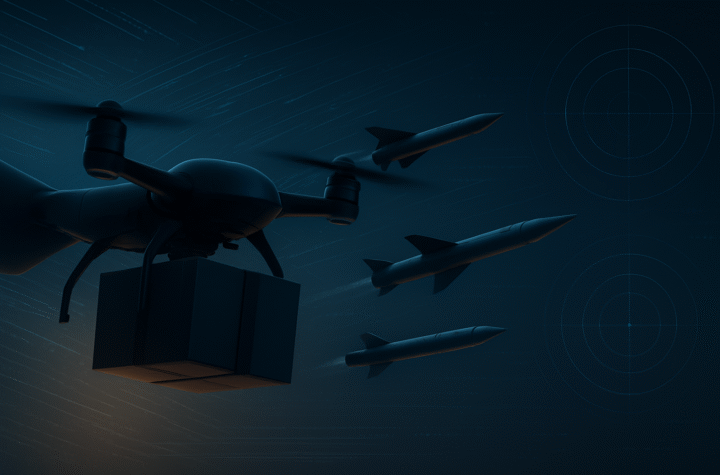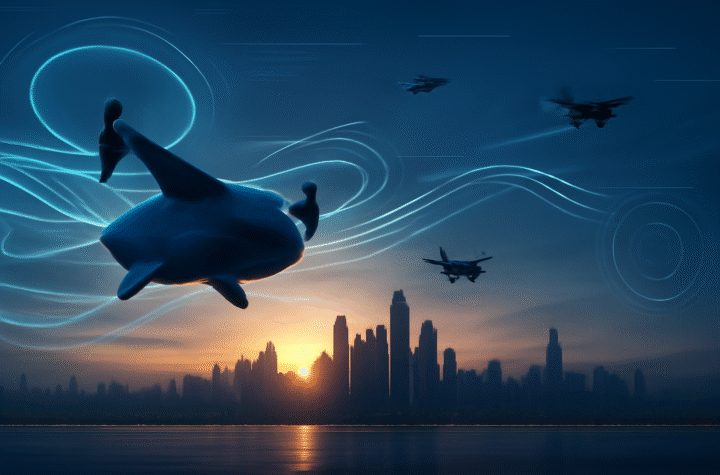
Top 10 Powerful Vertical Takeoff Aircraft & Drones
📷 1. Air One – The First Consumer‑Grade eVTOL
Overview:
Developed by Israeli startup AIR, Air One is a pioneering two-seat eVTOL designed for ordinary consumers. This electric flying car is built to fit in a standard garage and operated by both pilots and non-pilots, thanks to intuitive controls and safety automation.
Design & Specs:
- Configuration: 8 electric rotors arranged on a multicopter frame with folding fixed wings and a pop-up cockpit canopy—optimizing for storage and flight.
- Performance: Up to 110 miles (177 km) on a charge, maximum cruise speed of ~155 mph (250 km/h), and roughly one hour of flight endurance.
- Control Interface: “Fly‑by‑intent” system interprets pilot intention and handles flight dynamics with AI—minimizing workload.
Milestones & Status:
- Completed hover testing in June 2022 and full performance trials by late 2022.
- Wings foldwards to a compact size for home parking.
- Currently in advanced stages of FAA certification with targeted rollout in 2024–25 and over 2,200 pre‑orders at ~US $150,000.
Why It Matters:
Air One isn’t just another eVTOL—it’s one of the first aircraft designed specifically for personal ownership. By marrying garage-friendly design with user-friendly autopilot and safety systems, it’s bringing aviation into everyday life.
📷 2. Archer Midnight – Urban Air Taxi with Airline Backing
Overview:
Midnight, created by Archer Aviation, is a five-seat piloted eVTOL crafted for high-frequency urban routes—particularly ideal for linking airports with city centers.
Design & Specs:
- Lift + Cruise Architecture: Six tilting motors for vertical operations and a fixed-wing setup for efficient cruise flight.
- Performance: Offers a ~100‑mile (160 km) range, cruises up to 150 mph (241 km/h), and operates at noise levels around 45 dBA—much quieter than helicopters.
- Safety & Redundancy: Multiple electric motors and separate battery packs ensure reliable performance and system failure resilience.
Milestones & Partnerships:
- First full transition flight (hover → forward flight) occurred in June 2024 at over 100 mph.
- FAA Special Airworthiness certification obtained in 2023 alongside U.S. Air Force involvement (Agility Prime).
- Orders include ~$1 billion from United Airlines and $500 million from Japan Airlines. Infrastructure efforts are underway for vertiports in collaboration with Stellantis and Falcon Aviation.
Why It Matters:
Midnight is setting a new bar for urban air travel: quiet, efficient, and backed by airline-scale investment. It’s a front-runner in the race to start commercial flights in 2025–26.
📷 3. Joby S4 – Tilt‑Rotor Champion on the Cusp of Commercial Service
Overview:
Joby Aviation’s S4 leverages 15+ years of R&D to deliver a five-seat tilt-rotor eVTOL aimed at launching as an air taxi by 2025. It blends helicopter agility with fixed-wing cruising efficiency.
Design & Specs:
- Tilt‑Rotor Design: Six tilt-capable rotors for vertical flight and efficient cruising once leveled out.
- Performance: 150 mi (241 km) range, 200 mph (322 km/h) cruise speed, and noise levels about 100× quieter than helicopters.
- Safety: Distributed electric propulsion, redundancy, and advanced flight control systems.
Milestones & Infrastructure:
- On April 22, 2025, completed first fully-crewed tilt–transition flight—shifting from vertical lift to cruise mode.
- Over 40,000 test flight miles logged.
- Secured FAA Special Airworthiness approval and Agility Prime funding.
- Preparing for commercial rollout in Dubai and U.S. city corridors with Toyota & Delta backing; production scaling in Ohio in 2025.
Why It Matters:
The successful piloted tilt–transition flight is a key technical milestone. Combined with quiet performance, long range, and a production roadmap, Joby S4 is positioned to redefine eVTOL operations in the coming year.
📷 4. AutoFlight Prosperity‑Gen4 – Inter-City eVTOL Powerhouse

Overview:
AutoFlight’s fourth-generation passenger eVTOL, Prosperity I, blends lift+cruise propulsion and fixed-wing efficiency for inter-city travel. A joint China‑Germany development, it aims to connect major metro areas with low operating cost.
Design & Specs:
- Layout: Fixed wings plus vertical lift props + three pusher fans for forward thrust doroni.io+14aaminternational.com+14aviationtoday.com+14newatlas.com
- Performance: ~155 mi (250 km) range, cruise speed 124 mph (200 km/h) evdesignandmanufacturing.com+8aaminternational.com+8evtol.news+8
- Capacity: 1 pilot + 4 passengers; MTOW ~2,220 kg; ~13 electric motors aaminternational.com+2evtol.news+2evtol.news+2
Milestones:
- Feb 2023: 250 km record flight, longest eVTOL flight to date evtol.news+15newatlas.com+15aviationtoday.com+15
- Flight achieved at ~124 mph, remotely piloted, over 1h 38min with 20 laps evtol.news+5autoflight.com+5aaminternational.com+5
- Full-scale transition test in early 2022; production spec “V2000EM” on track with EASA & Chinese certifications by 2025 aviationtoday.com
Why It Matters:
Breaking the endurance record validates its inter-city use case—helping shape global urban air mobility. With long-range, sizable cabin, and regulatory momentum, it’s emerging as a viable commercial eVTOL vendor.
📷 5. ASKA A5 – The Drive‑and‑Fly Flying Car

Overview:
The ASKA A5 is a four-seat roadable eVTOL—part car, part aircraft—folding into drive mode like a compact SUV and converting to electric VTOL flight. California-developed, seeking FAA and DMV dual certification.
Design & Specs:
- Hybrid Powertrain: Battery-electric eVTOL flight plus gas-engine range extender for emergency backup startupselfie.net+15askafly.com+15ainonline.com+15
- Performance: 250 mi (400 km) flight range, VTOL + short-takeoff land (STOL) capability, six motor systems, ballistic parachute compositesworld.com+3askafly.com+3urbanairmobilitynews.com+3
Milestones:
- FAA special airworthiness granted July 2023; over 350 tethered hover tests completed urbanairmobilitynews.com+2askafly.com+2aaminternational.com+2
- Full-scale prototype conducted tethered hover test in mid-2023 evtol.news+6compositesworld.com+6urbanairmobilitynews.com+6
Why It Matters:
By enabling both driving and flying, ASKA bridges two transportation worlds. The A5 may redefine personal mobility with door-to-door functionality, leveraging existing roads and new vertiports.
📷 6. Doroni H1‑X – Compact Suburban eVTOL
Overview:
Doroni H1‑X is a two-seater ducted-fan eVTOL aimed at suburban mobility and garage storage. Safety, noise reduction, and everyday usability drive its design.
Design & Specs:
- Design: Fully enclosed four-fan ducted rotor system, modular carbon-fiber body askafly.com+4evtol.news+4urbanairmobilitynews.com+4
- Performance: 100 mi range, 95 mph cruise speed, 120 mph top speed; 60 min flight; 25 min recharge; 500 lb payload doroni.io
- Dimensions: ~23×15×5.5 ft, fits in standard two-car garage newatlas.com+3newatlas.com+3aaminternational.com+3
Milestones:
- Full-scale hover tests slated for 2024; MSRP ~$135–150 K; pre-orders opening in 2024 zapata.com+15evtol.news+15evtol.news+15
Why It Matters:
The H1‑X is among the first eVTOLs designed for everyday suburban use—compact, quiet, and accessible to ordinary households and municipalities.
📷 7. Vertical Aerospace VX4 – Airline‑Grade Urban Air Taxi
Overview:
British-made VX4 by Vertical Aerospace is a 1‑pilot + 4‑passenger eVTOL with commercial airline-grade systems and partnerships including Rolls‑Royce, Leonardo, American Airlines.
Design & Specs:
- Layout: Fixed-wing with eight electrically-driven tilt-props; carbon composite build aaminternational.com+3doroni.io+3vtol.org+3youngresearch.com+10evtol.news+10aaminternational.com+10aaminternational.com+1newatlas.com+1
- Performance: 150 mph cruise, 100+ mi range; fast battery turnaround newatlas.com+2aaminternational.com+2thetimes.co.uk+2
Milestones & Plans:
- Full-scale VX4 prototype will commence wingborne flight in Q2 2025; certification efforts ongoing vertical-aerospace.com+1youngresearch.com+1
- Cross-country UK autonomous flight in mid-2025; UK & U.S. certification by 2028; secured $50M funding lifeline ft.com
Why It Matters:
VX4 is pushing commercial viability by aligning with airlines and global regulators, with strong safety protocols and price support to lead the eVTOL mainstream market.
📷 8. Transwing X‑P Series – Folding‑Wing VTOL for Mobility & Defense
Overview:
Transwing, designed by U.S. firm PteroDynamics, features folding wings that pivot between vertical and horizontal flight. This innovative form factor suits logistics, autonomy, and defense use.
Design & Specs:
- Mechanism: Patented folding-wing design-switches between helicopter-like VTOL and efficient airplane modes
- Benefits: Autonomous operations, high payload, compact storage footprint pterodynamics.com
Milestones:
- XP‑4 UAV delivered to U.S. Navy Air Warfare Center in 2022; sea trials and shipboard landings achieved interestingengineering.com+2evtol.news+2businessinsider.com+2
Why It Matters:
By enabling both runway-free deployment and aerodynamic flight, Transwing sets a new standard for flexible VTOL platforms—especially useful in remote logistics and aerial defense.
📷 9. SkyDrive SD‑05 – Japan’s Expo‑Debut eVTOL
Overview:
Developed by Toyota-backed SkyDrive, the SD‑05 is a compact two-seater eVTOL aimed at urban routes, showcased at the 2025 Osaka Expo and targeting Japanese & U.S. certification.
Design & Specs:
- Passenger Capacity: Pilot + 1 passenger
- Performance: ~15–20 km range (~10–12 mi), speeds up to 100 km/h (~62 mph) for short urban links businessinsider.com+2evtol.news+2pterodynamics.com+2evtol.news+4businessaviation.aero+4aero-news.net+4evtol.news+2aaminternational.com+2aaminternational.com+2
- Rotor Design: Patent-pending rotor dome for safety and noise suppression en.skydrive2020.com
Milestones:
- Public flight demo at Osaka Expo Media Day on April 9, 2025 aero-news.net
- Japan CAA certification in 2021; FAA pre-application accepted in June 2024; MoU in South Carolina for pre-orders askafly.com+2en.skydrive2020.com+2evtol.news+2
Why It Matters:
SD‑05 is an early mover in Asian urban air mobility—compact, low-speed, easy to integrate into cities, and publicly validated during a major world expo.
📷 10. Zapata Airscooter – One‑Man Ultralight VTOL Adventure
Overview:
Invented by Franky Zapata (creator of Flyboard), the Airscooter is an ultralight, single-passenger VTOL egg used recreationally and approved under FAA Part 103—no pilot’s license required.
Design & Specs:
- Specifications: 340 × 340 × 256 cm; 115 kg empty; 120 kg max payload; 2 hr endurance; climb to 3,000 m; ~80 km/h cruise speed aaminternational.com+5businessaviation.aero+5en.skydrive2020.com+5evtol.news+4bike-ev.com+4zapata.com+4
- Propulsion: 12-rotor hybrid-electric/ky jet system; fly-by-wire controls for stabilization
Market & Access:
- Part 103 ultralight: no pilot’s license required in USA
- Now available for experience flights (~US $200/session) in Lake Havasu City, Arizona ev.motorwatt.com
- Estimated price: US $128K newatlas.com+2ev.motorwatt.com+2evtol.news+2
Why It Matters:
Airscooter democratizes VTOL flight for recreation and light utility without regulatory burdens—it’s a glimpse into the future of personal airborne experiences.




More Stories
Defense Advanced Research Projects Agency(DARPA)-7
DJI Matrice 400 Takes Flight: A Game-Changer for Enterprise Drone Operations
Sky Smarts: How AI Is Revolutionizing Drone Navigation in Delivery and Rescue Missions